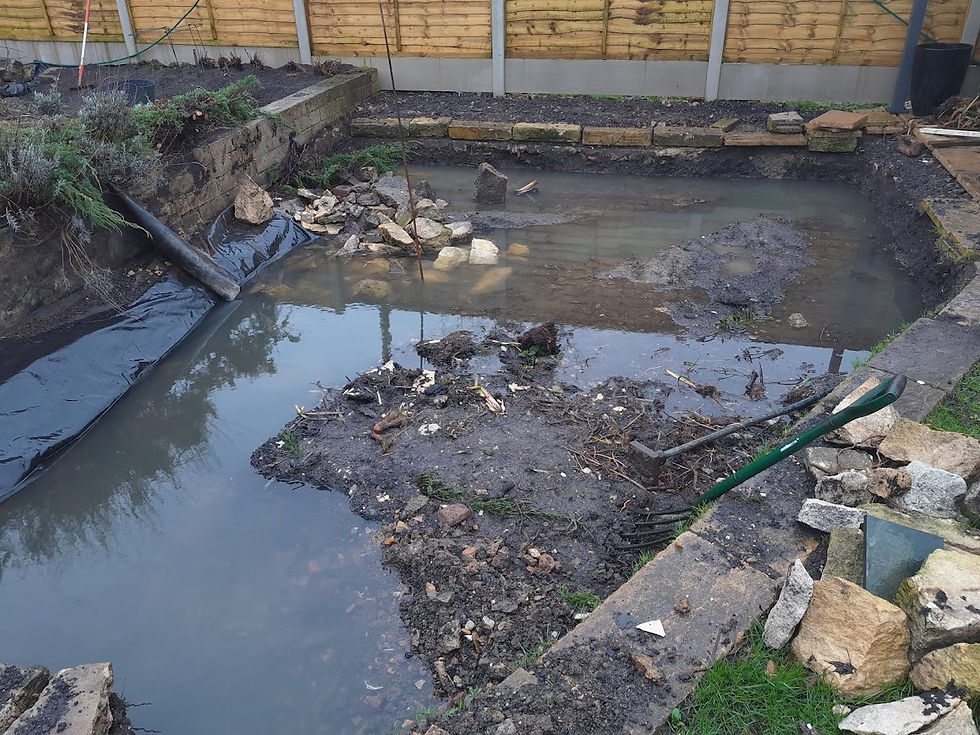Ponds
- robinlancefield
- Jun 3
- 3 min read
After the deluge this winter (2023/24) you probably already have a few ponds in your garden even if you don’t want them. I cannot remember a wetter year, my vegetable patch has been underwater since November, just as it dries out another wave of rain arrives. What better time then to build a pond?
Ponds are a great way to encourage wildlife into the garden. Build it and they will arrive! Frogs, newts, dragon flies, etc. Many birds will drink from the pond if you design it right. Perhaps not so welcome if you have fish will be herons and even otters.
After a bit of a garden redesign I decided to replace and enlarge one I built many years ago that had become choked with pond weeds and had a hole in the liner.

Having some time available I decided to build a bigger pond, approximately 6m (20ft) by 7m (23ft). One consideration when building a pond is what to do with all the arisings. I knew I had about 30cm of “soil” overlying clay, so I decided to reuse the soil for some raised beds, and to stockpile the clay down the garden for either disposal or another project. To reuse the soil I had to sieve it first to remove stones and about 4 buckets of glass, nails and screws. The resulting soil is great though, albeit a bit time consuming to sieve.
There are several ways of constructing a watertight pond, concrete, puddled clay and a liner. The liner approach is the simplest and most likely to succeed for non-expert pond diggers.
A few things to consider when planning a pond. Try to avoid areas under trees; whilst the shading is good, the leaves will fall into the pond affecting water quality, and there are likely to be roots in the way. The pond also needs to be level, otherwise parts of the liner will show (look up how to level a pond online if not sure). Because this part of my garden is roughly level, I tend to level by eye. Another consideration is the groundwater level in your garden. If it is too high, it may be difficult to install the pond liner. I had to wait for the groundwater level to drop several times during the construction.

Ponds do not need to be very deep, and ideally need shallow areas for marginal planting. So my pond will be a maximum depth of 75cm (just over 2ft) with ledges about 30cm (1 ft). Try to plan a means of escape for any wildlife that may fall in.
You also need to plan how you intend to construct the edges of the pond. From previous experience, I recommend considering access issues, and also making the edges as low maintenance as possible. For this pond I have one side as a rockery (it backs onto a low wall, the rockery covers up the wall), one side edged with railway sleepers (which form a shallow raised bed for planting), and the rest with paving slabs. Plan for a slight overlap so the liner is hidden. Also make sure that the edge is secure, so concrete in the paving slabs. I have tried edging ponds with turf in the past, but I have found that they are hard to maintain, the wet edge of the grass tends to grow well, and invade the pond.

Once the construction is complete you then need to plant and stock the pond. When buying pond plants remember they are very vigorous, so buy small plants, and only buy a few. Within a few years you will have too many. I tend to plant some yellow flag irises in the margins, some pond aeration weed in the depths, and some water lilies, which as well as looking good, provide shade and help prevent algae growth.
I stock with a few cheap goldfish. I find if you do not overstock with fish: frogs and newts will live happily alongside. Another reason is that we are visited by herons, so spending big money on fish is a waste of time (well, unless you like feeding herons). There have also been otter sightings in the area; they will wipe out all your fish if they visit. If you go down the expensive fish route you will also need to add a pond filter, and probably net the pond to deter herons and cats.
I started this pond mid December 2023, and completed it in April 2024. A lesson learned is not to build a pond during one of the wettest winters on record!





Comments